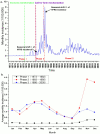Spatiotemporal trends and climatic factors of hemorrhagic fever with renal syndrome epidemic in Shandong Province, China
- PMID: 20706629
- PMCID: PMC2919379
- DOI: 10.1371/journal.pntd.0000789
Spatiotemporal trends and climatic factors of hemorrhagic fever with renal syndrome epidemic in Shandong Province, China
Abstract
Background: Hemorrhagic fever with renal syndrome (HFRS) is a rodent-borne disease caused by Hantaviruses. It is endemic in all 31 provinces, autonomous regions, and metropolitan areas in mainland China where human cases account for 90% of the total global cases. Shandong Province is among the most serious endemic areas. HFRS cases in Shandong Province were first reported in Yutai County in 1968. Since then, the disease has spread across the province, and as of 2005, all 111 counties were reported to have local human infections. However, causes underlying such rapid spread and wide distribution remain less well understood.
Methods and findings: Here we report a spatiotemporal analysis of human HFRS cases in Shandong using data spanning 1973 to 2005. Seasonal incidence maps and velocity vector maps were produced to analyze the spread of HFRS over time in Shandong Province, and a panel data analysis was conducted to explore the association between HFRS incidence and climatic factors. Results show a rapid spread of HFRS from its epicenter in Rizhao, Linyi, Weifang Regions in southern Shandong to north, east, and west parts of the province. Based on seasonal shifts of epidemics, three epidemic phases were identified over the 33-year period. The first phase occurred between 1973 and 1982 during which the foci of HFRS was located in the south Shandong and the epidemic peak occurred in the fall and winter, presenting a seasonal characteristic of Hantaan virus (HTNV) transmission. The second phase between 1983 and 1985 was characterized by northward and westward spread of HFRS foci, and increases in incidence of HFRS in both fall-winter and spring seasons. The human infections in the spring reflected a characteristic pattern of Seoul virus (SEOV) transmission. The third phase between 1986 and 2005 was characterized by the northeast spread of the HFRS foci until it covered all counties, and the HFRS incidence in the fall-winter season decreased while it remained high in the spring. In addition, our findings suggest that precipitation, humidity, and temperature are major environmental variables that are associated with the seasonal variation of HFRS incidence in Shandong Province.
Conclusions: The spread of HFRS in Shandong Province may have been accompanied by seasonal shifts of HTNV-dominated transmission to SEOV-dominated transmission over the past three decades. The variations in HFRS incidence were significantly associated with local precipitation, humidity, and temperature.
Conflict of interest statement
The authors have declared that no competing interests exist.
Figures




Similar articles
-
Spatial analysis of hemorrhagic fever with renal syndrome in Zibo City, China, 2009-2012.PLoS One. 2013 Jun 28;8(6):e67490. doi: 10.1371/journal.pone.0067490. Print 2013. PLoS One. 2013. PMID: 23840719 Free PMC article.
-
The epidemic characteristics and changing trend of hemorrhagic fever with renal syndrome in Hubei Province, China.PLoS One. 2014 Mar 21;9(3):e92700. doi: 10.1371/journal.pone.0092700. eCollection 2014. PLoS One. 2014. PMID: 24658382 Free PMC article.
-
Spatio-temporal evolution on geographic boundaries of HFRS endemic areas in Shandong Province, China.Biomed Environ Sci. 2013 Dec;26(12):972-8. doi: 10.3967/bes2013.032. Biomed Environ Sci. 2013. PMID: 24393506
-
Transmission of haemorrhagic fever with renal syndrome in china and the role of climate factors: a review.Int J Infect Dis. 2015 Apr;33:212-8. doi: 10.1016/j.ijid.2015.02.010. Epub 2015 Feb 19. Int J Infect Dis. 2015. PMID: 25704595 Review.
-
Epidemiological progresses of hemorrhagic fever with renal syndrome in China.Chin Med J (Engl). 1999 May;112(5):472-7. Chin Med J (Engl). 1999. PMID: 11593522 Review.
Cited by
-
Ecology and geography of hemorrhagic fever with renal syndrome in Changsha, China.BMC Infect Dis. 2013 Jul 3;13:305. doi: 10.1186/1471-2334-13-305. BMC Infect Dis. 2013. PMID: 23819824 Free PMC article.
-
The changing epidemiology of hemorrhagic fever with renal syndrome in Southeastern China during 1963-2020: A retrospective analysis of surveillance data.PLoS Negl Trop Dis. 2021 Aug 6;15(8):e0009673. doi: 10.1371/journal.pntd.0009673. eCollection 2021 Aug. PLoS Negl Trop Dis. 2021. PMID: 34358248 Free PMC article.
-
Genetic Diversity and the Spatio-Temporal Analyses of Hantaviruses in Shandong Province, China.Front Microbiol. 2018 Nov 20;9:2771. doi: 10.3389/fmicb.2018.02771. eCollection 2018. Front Microbiol. 2018. PMID: 30524397 Free PMC article.
-
Intrinsic and extrinsic drivers of transmission dynamics of hemorrhagic fever with renal syndrome caused by Seoul hantavirus.PLoS Negl Trop Dis. 2019 Sep 23;13(9):e0007757. doi: 10.1371/journal.pntd.0007757. eCollection 2019 Sep. PLoS Negl Trop Dis. 2019. PMID: 31545808 Free PMC article.
-
Changes in diversification patterns and signatures of selection during the evolution of murinae-associated hantaviruses.Viruses. 2014 Mar 10;6(3):1112-34. doi: 10.3390/v6031112. Viruses. 2014. PMID: 24618811 Free PMC article.
References
Publication types
MeSH terms
LinkOut - more resources
Full Text Sources
Other Literature Sources
Miscellaneous

